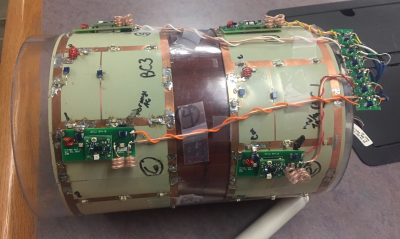1732
Nested Birdcage Receive Array for Simultaneous Multislice EPIKenneth M Bradshaw1, Daniel Sheltraw2, Greyson Tarbox3, and Ben Inglis4
1ECEn Department, Brigham Young University, Provo, UT, United States, 2University of California - Berkeley, Berkeley, CA, United States, 3ECEn, Brigham Young University, Provo, UT, United States, 4UC BerkeleyUniversity of California - Berkeley, Berkeley, CA, United States
Synopsis
We present a novel RF coil design that is capable of simultaneous multi-slice (SMS) echo planar imaging (EPI) for functional MRI along the z axis at 3 T, while maintaining high in-plane (x-y) homogeneity to minimize the effects of receive field contrast on subject motion and motion correction. The coil is symmetric and is open front and rear, making it compatible with fMRI stimulus devices including transcranial magnetic stimulation (TMS) coils.
Introduction
Our center has dual needs in a larger, phased-array receive-only RF coil for its 3 T MRI scanner. Researchers need (i) a large aperture RF coil capable of holding a trans-cranial magnetic stimulation (TMS) “figure 8” coil on a position adjacent to a subject’s scalp, with the subject lying supine and symmetrically with respect to the main magnetic field, and (ii) an RF coil capable of applying simultaneous multi-slice (SMS) echo planar imaging (EPI) for functional MRI from the subject, with SMS acceleration in the z direction (axial EPI). At present we have two separate coils: a CP birdcage coil with the correct aperture for inclusion of a TMS coil but that is incapable of SMS-EPI. The other has 32 receive channels and is capable of SMS-EPI but fits tightly over a subject’s head with no space for a TMS coil. We present here a novel coil design dubbed a “nested birdcage” coil that provides simultaneously a larger volume, receive field heterogeneity along the coil axis and receive field homogeneity across the coil. Heterogeneity along z permits use of SMS acceleration while high in-plane homogeneity minimizes motion-related errors such as “anchoring” of the lab frame contrast when performing volume realignment for motion correction.(1) The central design concept is to concatenate multiple birdcage coil elements into a single coil phased-array nested birdcage.Methods
To test this idea, we constructed a 50% scale prototype consisting of three birdcage coils each having 4 coils consisting of 8 legs, 8 cm long and placed on a 16-cm diameter plastic form, as seen in Figure 1. To have phase freedom as well as spatial separation, the coils can be rotated relative to each other. To do this the middle coil is placed on the inside of the end coils. Preamps are placed at each quadrature’s feed points for a total of 6 channels for the assembled coil. Each leg has capacitors for tuning. (It was decided to use the low pass configuration instead of high pass because too many resonances would appear in the output.) Tuning of each coil is accomplished by shorting out the legs of the other coils. Decoupling is determined by S21 (forward gain s-parameter) measurements between channels. Decoupling of at least -14 dB is the goal. Decoupling between quadrature channels on the same coil was at least -6 dB. Next nearest neighbor decoupling is achieved by having high impedance (400 and 900 ohms) on the matching capacitors at various feed points. When loaded the preamps will see an impedance of 150 ohms.Results
Using SMS-EPI sequences, the coils demonstrated good decoupling between channels and the potential for 3-fold acceleration in the z-direction. (Figure 2) It was also noted that because there are two channels on each coil, acceleration might be achieved in the xy-plane. Acceleration in-plane was not in our original design specifications for SMS-EPI but is a useful feature for anatomical scanning, such as MP-RAGE, when phase encoding acceleration (e.g. GRAPPA) is commonly used.Discussion
Large artifacts were seen with the first prototype because of the presence of connecting coax cable. For bench measurements, it was okay to use RG178 (steel center conductor) but became problematic in imaging. (The cables were replaced prior to submission and the artifacts disappeared.) The next phase of testing will involve evaluation of phase encoding acceleration in anatomical scans before deciding on a final configuration for a full-sized human head coil. The favored option is to simply scale the prototype but we are also considering expanding the array to five nested birdcages in a second scaled prototype.Conclusion
We have shown that an assembly of birdcage coils on the same diameter can be decoupled and be used with confidence for SMS imaging. It is expected that more acceleration can be achieved with preamps on each coil loop of the “nested” birdcage coils. The geometry of a nested birdcage design is expected to be more flexible for many neuroscience applications when a close-fitting large array coil is prohibitive.Acknowledgements
No acknowledgement found.References
1Sheltraw, D, Inglis, B, “The Effects of Receive Field Contrast on Motion-Corrected EPI Time Series: A Simulation of a 32 Channel Receive Array,” ISMRM 2013, #3352

